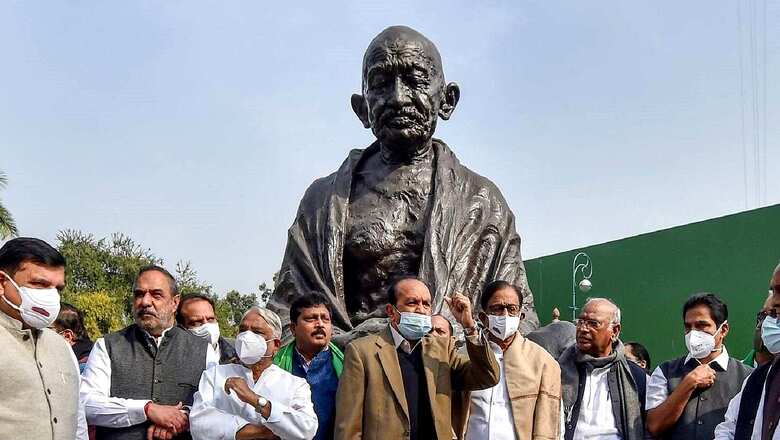
views
The suspension of 12 Rajya Sabha MPs for indecorous behaviour in the preceding Monsoon Session was among the issues that led to stormy scenes in the Upper House, leading to an adjournment right as the Winter Session got underway. When a House is meeting, its presiding officer may ‘adjourn’ the proceedings due to disorder among its members. Then there is the ‘adjournment motion’, which is taken up when a House wants to put on hold other work to discuss any important matter. The Parliament can also be ‘adjourned sine die’, most often, when a session is deemed to have been concluded. Here’s all you need to know.
When Can A House Be Adjourned?
Unruly scenes, chaos and disturbance. When a House of Parliament is witness to such episodes, the presiding officer can order the sitting adjourned. The rules in this regard are the same for both the Lok Sabha and the Rajya Sabha.
In Lok Sabha, the Speaker, can invoke Rule 375 of the ‘Rules of Procedure and Conduct of Business’ to adjourn the House or suspend any sitting “in the case of a grave disorder arising in the House”. Such adjournment is to be done when the Speaker “thinks it necessary to do so” and can extend “for a time to be named by the Speaker”. The Chair of the Rajya Sabha has similar powers under Rule 275 of the House business.
These powers were invoked during the Monsoon Session of 2021 as the Parliament was rocked by the Pegasus spyware affair and the protests against the farm laws.
The 16th Lok Sabha, which ran from 2014-2019, is said to have lost 16 per cent of its scheduled time to disruptions. According to PRS Legislative Research, that was “better than the 15th Lok Sabha (37 per cent), but worse than the 14th Lok Sabha (13 per cent). The Rajya Sabha lost 36 per cent of its scheduled time in the 16th Lok Sabha as against 32 per cent and 14 per cent, respectively, during the 15th and 14th Lok Sabhas.
ALSO READ: Friday First Show, But Hardly Blockbusters. How Private Member Bills Are Tabled And Why They Mostly Fail To Clear Parliament
What Is Adjournment Motion?
A House, then, is invariably adjourned over some issue that may have agitated members to such an extent that its ordinary business cannot be taken up. To allow members to raise concerns and flag important issues, parliamentary rules also allow for the tabling of what is known as an “adjournment motion“.
According to the Lok Sabha Secretariat (LSS), “the primary object of an adjournment motion is to draw the attention of the House to a recent matter of urgent public importance having serious consequences”. It can be taken up “by interrupting the normal business of the House” if it is deemed that following the normal course of seeking a discussion through a “motion or a resolution with proper notice will be too late”.
However, it should concern a matter that is “very grave (and) which affects the whole country and its security”. LSS adds that “the subject matter of the motion must have a direct or indirect relation to the conduct or default on the part of the Union government and must precisely pinpoint the failure of the Government of India in the
performance of its duties in accordance with the provisions of the Constitution and law”. In that respect, PRS Legislative Research says, “the adoption of an adjournment motion is seen as a censure of the government, although there is no compulsion on the government to resign”. It adds that in the 16th Lok Sabha, only one adjournment motion was admitted.
During the 2021 Monsoon Session, adjournment motions were filed by the Opposition parties on the Pegasus spyware issue and on the border dispute between Assam and Mizoram.
How Is An Adjournment Motion Taken Up?
Being in the nature of a censure of the Union government, an adjournment motion can only be moved in the Lok Sabha, since the Union Council of Ministers is “collectively responsible” to the Lower House of Parliament.
The adjournment motion is thus an extraordinary procedure. If taken up, it leads to the setting aside of the normal business of the House for a discussion on the matter over which it was moved.
The notice for moving an adjournment motion has to be given “normally three working days before the
commencement of the session” in which it is proposed to be moved. When a session is in progress, notice of an
adjournment motion should be given by 10 am on the day on which the motion is proposed to be made. If a notice is received after 10 am, it is treated as one given for the next sitting.
If the Speaker gives his assent to the moving of an adjournment motion, it can be taken up after the Question Hour. The member bringing up the motion has to have the backing of at least 50 fellow members. Once the required support is established, the motion ‘that the House do now adjourn’ shall be taken up at 1600 hours or at an earlier time if the Speaker so decides.
However, “refusal to give consent is in the absolute discretion of the Chair and the Chair is not bound to give any reasons” for it. The Speaker can refuse consent without bringing the matter before the House and “the member concerned will be verbally informed of the Speaker’s decision”.
What Is Adjournment Sine Die?
This one is simpler. Adjournment, it would be clear now, implies a putting off of a matter or business. ‘Sine die’ is Latin for “without a day”. Adjournment sine die thus means putting off indefinitely. Thus when adjournment sine die is announced, it means the “termination of a sitting of the House without any definite date being fixed for the next sitting”.
Such an announcement is normally made when the business of the Parliament for a particular session is deemed to have been completed. But such adjournment can also be done under extraordinary circumstances, as when cessation of the Budget Session of 2020 was called nearly 10 days ahead of its schedule due to the coronavirus pandemic.
The power to declare adjournment sine die is vested in the presiding officer of each House and they are also mandated to summon the next sitting after a House has been adjourned sine die.



















Comments
0 comment